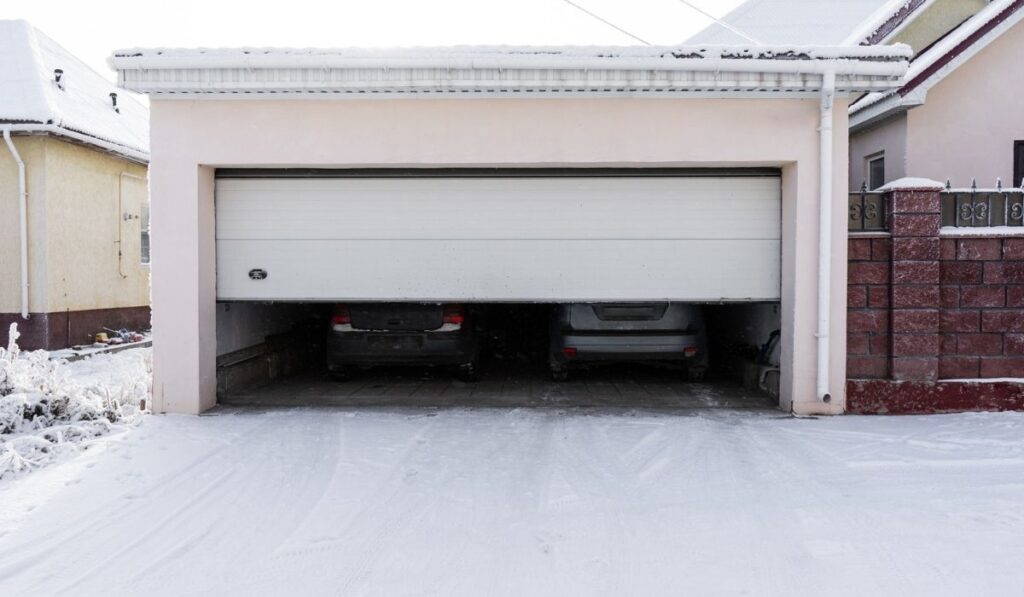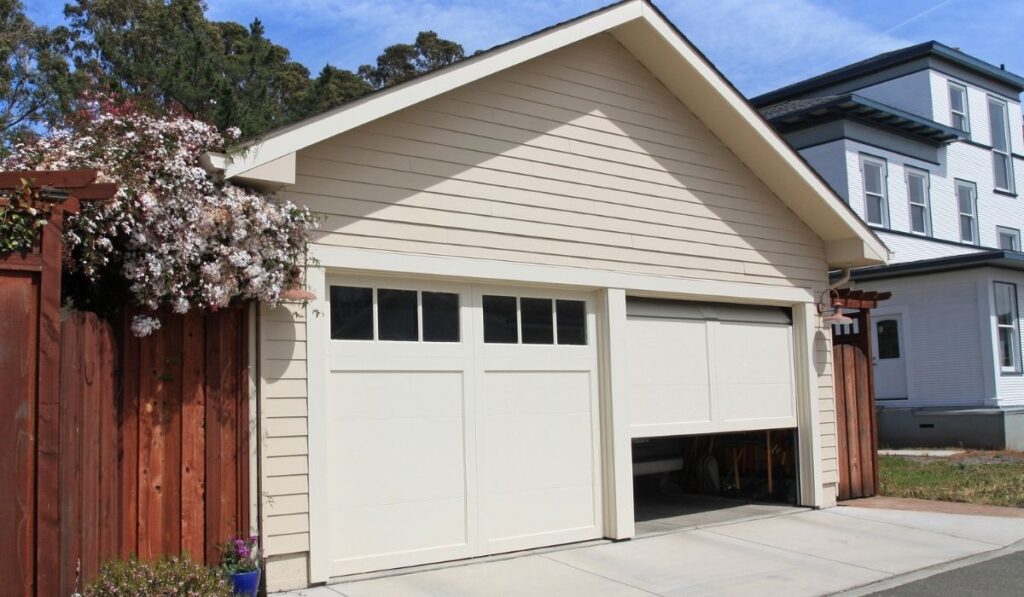Several factors can cause your garage door to open only partially. These factors may include blocked sensors, defective or broken springs, low batteries, a broken logic control board, contraction issues, and poor alignment of the sensor eye. The effects of cold and poor track alignment can also cause the garage door to open only partially. If your garage door only opens slightly, there are a handful of fixes you can try.
To fix your garage door, try changing the remote’s batteries, cleaning the sensors, reconnecting the power, adjusting the track rails, and lubricating hinges and rollers. You may also need to adjust the door’s limit switch using a flathead screwdriver. This may require professional assistance.
No matter how close your garage door is to opening or closing fully, a small gap still needs to be fixed. After all, what good is a partially-closed garage door? Luckily, many of the fixes are quick and easy. Some, however, may require professional services. If you’re not confident dealing with the door yourself, don’t risk it — these doors can be dangerous when broken. Let’s look at the various reasons why your door might not be closing properly and how to deal with each one.
How Do Garage Door Openers Work?

A garage door opener is a mechanical device that is regulated by switches on the garage wall to open or close the garage door. Most models come with a portable radio remote control that can also open and close the door from a short distance.
An automated garage door opener enables you to open and close the door with the simple press of a button. These garage door openers use radio frequencies, enabling the door to open or close when the frequencies match.
A curving arm fastens the door to a garage door opener, fastening it in its proper place. The motor leads the action of the door to open or close as desired, using the torsion spring system — or extension springs — to counterbalance the door’s weight, allowing for safe and steady movement.
The disadvantage of these openers is the use of similar frequencies. As a result, if your neighbors have the same system as you, they may use their remote to unintentionally open your garage door. Fortunately, the frequency of the garage door opener can be changed from inside the garage.
Why Isn’t Your Garage Door Opening All the Way?
When a garage door only opens a few inches, it can’t serve its purpose, and your garage becomes a bit useless.
Let’s look at what you can do when your garage door opens a few inches, whether it’s because of the force restriction or faulty springs. The goal is to troubleshoot the problem, locate it, and fix it appropriately.
The following are ten reasons your garage door might only be opening a few inches:
Dirty or Clogged Sensors
It’s often the case that the most likely explanation is the correct one. In this case, it might just be that the door is dirty or clogged.
The first thing to do is check the sensors to see if something is blocking them. The sensors’ lenses may be filthy if there isn’t any obvious obstruction. Try again after giving them a good wipe down.
Throughout the garage door’s life, you will observe a buildup of filth, spider webs, dust, etc. Clean the sensors regularly. Wipe down the lenses once in a while to spare yourself the time spent fixing them. Clear the lens of any constraint with a moist cloth or cleaning wipe.
Dead or Low Garage Remote Batteries
Another straightforward explanation is that the batteries in the garage door remote need to be replaced. Low batteries can hinder the signals sent to the receiver. As a result, the garage door opens only a few inches before coming to a halt. Replace the batteries if necessary.
When replacing the batteries, ensure to use only high-quality, long-lasting batteries. Then, to see if the problem has been repaired, try opening the garage door again.
Power Deficit
If there’s a power deficit for any reason, the garage door will likely only open a few inches. When the power goes out, the garage door opener and the garage door itself can become disconnected. The solution to this challenge is to disconnect and then reconnect it. Make sure you turn off the power for about 30 seconds before reconnecting it.
Faulty Springs
A garage door may have trouble opening because of a malfunctioning internal component. Fortunately, checking for damaged springs is pretty simple.
An attempt to open the door manually is one quick way to check the integrity of the internal components. First, remove the plug from the outlet. Then, try to lift the door manually.
It should be able to move around with relative ease. If it doesn’t, or if it feels very heavy, the issue is with the mechanism that opens the door.
It is preferable to leave any problem with the opening mechanism to a specialist. Handling garage door springs is quite dangerous. If something goes wrong, major harm or even death can result.
Issues With Track Alignment
The garage door track could be another major culprit. The garage door may not open completely when the rails get bent or out of shape.
Adjust the track rails with a rubber mallet. This is usually a simple do-it-yourself project. In most situations, you can amend track alignment with a rubber mallet and a level. You can also hire the services of an expert if you prefer.
Binding Issues
You can also physically open and close the door to examine if something is binding it. If any binding occurs, the force limit or basic travel limit may need to be adjusted.
It’s a good idea to consult the owner’s handbook for instructions on how to make these changes. There are two options depending on the model or brand of your garage door. Turn the screws or press the colored buttons.
If you can’t find the owner’s manual, a quick search on Google should suffice. After all repairs and adjustments, check twice to be sure it’s working perfectly.
Malfunctioning Logic Control Board
The logic control board should come to your mind when the garage door opens but suddenly stops. The logic board’s job is to receive signals and then act on them. Remotes or keypads that are connected to the garage can send these signals.
What if your door isn’t operating correctly, but there aren’t any obstacles in the way, and you can manually open and close it? In this situation, the most likely cause is the logic control board.
Replacing the logic control board is a great option, but it should also be the last option. A simple refresh can perform wonders, just like any other electronic component. Refresh after some time to be sure it’s in perfect condition.
Cold-Weather Effects
The effects of cold weather can damage a variety of things. The aforementioned problems will probably resurface from time to time. When the weather becomes cold, it might exacerbate the problem. There are a few things you can do to keep your garage door operating well in the winter.
If any hinges or rollers appear to be stuck, soak them in a solvent and scrub them clean with a stiff brush. Lubricate the bearings and pulleys. Spray the track, hinges, and rollers with a solvent.
Spray the springs, roller bearings, torsion, bar bearings, shuttle, and screwdriver with oil. It’s preferable to use a silicone-based lubricant like Leafy’s Sliding Door Lubricant (on Amazon) for this purpose.
Using your hands, manually open the garage door. Manual opening and closing your garage door until the weather warms up may be essential. If your door isn’t opening correctly because of the cold weather, the problem should go away when the temperature warms up.
Shrinkage and Contracture
Contraction is probably the most prevalent cause of your garage door not working properly during the winter. Simply put, because of the cold, the metal shrinks or contracts. When it gets cold, the space between molecules shrinks, and the metal shrinks.
If you’re certain shrinking and contraction are to blame for your problems, using lubricant is essential. Ensure that the hinges, springs, and any other metal components are lubricated because it helps to loosen up components, making it easier for the garage door to open easily.
In terms of lubrication, in the cold, the oil in your door’s components can condense and harden. When this happens, smooth operation becomes harder to attain. And, if left unattended for a long time, one of those components may fail, warranting maintenance.
To ensure effective maintenance, check the joints and track if your garage door only opens a little or not at all. Please make sure they’re oiled and lubricated appropriately. Use a grease solvent to remove any old grease and replace it with new lubrication. Keeping your garage door in good operation requires regular attention.
Broken Springs
The garage door’s springs are crucial to its operation. Your garage door will not work correctly if any of these components fail. It may not work at all in the worst-case scenario. Garage springs, unfortunately, can be stiff and fragile. The frail particles may become almost weak if the temperature goes very low.
If you suspect the problem is with the springs, get an expert to handle the work. Dealing with springs might be dangerous for someone unskilled. Preventative maintenance, regardless of the problem, is the most straightforward solution.
How Do You Reset the Limit on a Garage Door Opener?

Is your garage door acting strange? A limit switch that has been incorrectly programmed may prevent the door from fully opening or closing. Resetting the limit switch may be the key to resolving these issues. Below is how you can reset it in different situations.
If the Garage Door Doesn’t Open Fully
- To open your garage door, use the button on your remote. In inches, measure the remaining distance between the top and bottom of the garage door.
- To adjust the up limit switch on the side of the garage door opener, use a stepladder.
- With a flathead screwdriver, turn the bolt clockwise one full turn for every 3 inches you want the door to open.
- Open and close the garage door. If the problem continues, change the up limit switch until the door functions properly.
If the Garage Door Doesn’t Completely Close
- To close the garage door, press the button on your remote. Measure the distance in inches from the ground to the bottom of the garage door.
- Adjust the down limit, turning it one full turn counterclockwise for every 3 inches of space you measured.
- Close the garage door and open it again. If the problem remains, adjust the down limit switch until the door functions fully.
